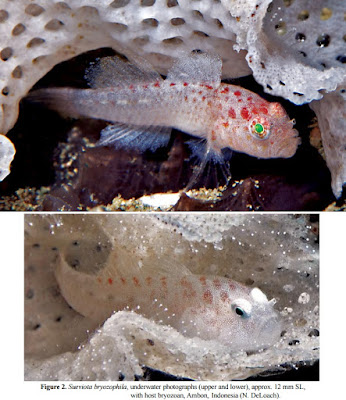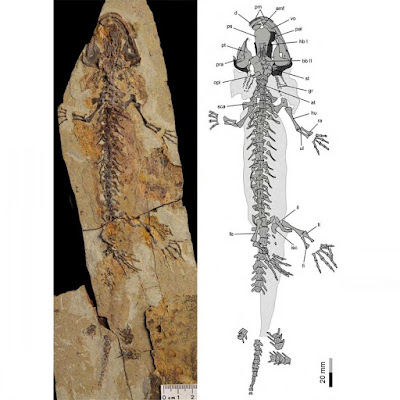[Most Recent Entries] [Calendar View]
Friday, May 6th, 2016
| Time | Event | ||
| 4:50a | [Ichthyology • 2015] Systematics and Morphology of Potamotrygon orbignyi (Castelnau, 1855) and allied forms (Myliobatiformes: Potamotrygonidae)
Abstract The Neotropical freshwater stingray Potamotrygon orbignyi (Castelnau, 1855), and other similar "reticulated" species occurring in northern South American basins, were submitted to a thorough taxonomic analysis based on an extensive external and internal morphological study. The identity of P. orbignyi and the taxonomic status of the related nominal species Potamotrygon dumerilii (Castelnau, 1855), Potamotrygon reticulata (Günther, 1880), and Potamotrygon humerosa Garman, 1913, are defined. Taxonomic and morphological analyses revealed that P. reticulata and P. dumerilii fall within the range of variation found in P. orbignyi and were consequently treated as junior synonyms, corroborating previous works. The extensive variation in coloration observed in P. orbignyi could not be divided into consistent morphotypes; P. orbignyi is therefore a widespread species in the upper, mid and lower Amazonas basin, the Orinoco drainage, and in rivers of Suriname and the Guianas. Additionally, P. humerosa and Potamotrygon marinae Deynat, 2007 were found to present characters that support their validity, and are redescribed based on newly collected material. Potamotrygon humerosa occurs predominantly in the mid and lower Amazonas River and in lower reaches of many of its affluents, whereas P. marinae is known only from French Guiana and Suriname. Characters that proved valuable as diagnostic indicators, either in combination or as derived features, are primarily from coloration, dermal denticles and spines (morphology, development and distribution), meristic features (e.g. numbers of tooth rows, vertebrae and mesopterygial radials), morphometric proportions (e.g. snout length, tail width at base and length), and size at sexual maturity. Keywords: Pisces, Taxonomy, Neotropical freshwater stingrays, anatomy, Potamotrygon humerosa, Potamotrygon marinae Silva, João P. C. B. D. and Marcelo R. de Carvalho. 2015. Systematics and Morphology of Potamotrygon orbignyi (Castelnau, 1855) and allied forms (Chondrichthyes: Myliobatiformes: Potamotrygonidae). Zootaxa. 3982(1): 1–82. DOI: 10.11646/zootaxa.3982.1.1 | ||
| 5:35a | [Ichthyology • 2016] Potamotrygon wallacei • A New Species of Neotropical Freshwater Stingray (Chondrichthyes: Potamotrygonidae) from the Rio Negro, Amazonas, Brazil: the Smallest Species of Potamotrygon
Abstract A new species of Potamotrygon is described from the Rio Negro drainage, Amazonas, Brazil. In spite of being cited or pictured several times in the scientific and aquarium fish literature since the 19th Century, it had been misidentified and still lacked a scientific name. Potamotrygon wallacei, n. sp., is diagnosed by the following characters: dorsal surface of disc light brown, with black irregularly-shaped vermiculate markings forming an amphora- or Ω-shaped figure on mid-disc, delimiting light brown reniform areas at disc center, and with subcircular light brown ocellate markings on disc margins; small body size (smallest known Potamotrygon species; largest examined specimen measured 310 mm DW); dorsal spines on tail usually rather low, without broad bases, in one to rarely three irregular rows, but extending posteriorly only to tail mid-length and not to caudal stings, with altogether relatively few spines; denticles on posterior mid-disc and tail base Y-shaped, with a central, anterior, bulbous cusp and usually two posterior pairs of smaller, rounded cusps; and single (anterior) angular cartilage. The new species is similar to P. orbignyi and other "reticulated" species in having a single (anterior) angular cartilage and in the color pattern of the tail, but is easily distinguished based on its size, dorsal tail spine arrangement, and specific details of color pattern. Keywords: Potamotrygon wallacei n. sp., Myliobatiformes, morphology, systematics, taxonomy, Pisces Marcelo R. de Carvalho, Ricardo S. Rosa and Maria Lúcia G. de Araújo. 2016. A New Species of Neotropical Freshwater Stingray (Chondrichthyes: Potamotrygonidae) from the Rio Negro, Amazonas, Brazil: the Smallest Species of Potamotrygon. Zootaxa. 4107(4); DOI: 10.11646/zootaxa.4107.4.5 | ||
| 5:45a | [Ichthyology • 2016] Sueviota bryozophila • A New Species of Coral-Reef Goby (Teleostei: Gobiidae) from Indonesia
Abstract A new species of gobiid fish, Sueviota bryozophila, is described from Indonesia, at Ambon, Molucca Islands and Lembeh Strait, North Sulawesi, on the basis of six specimens, 9.9–13.2 mm SL. The new species differs from the other four members of the Indo-Pacific genus by having reduced sensory pores on the dorsal surface of the head, with only paired pores at the mid-interorbital, and by having four pelvic-fin rays unbranched and a single branching of the fifth ray. Moreover, the new species is unique among both Sueviota and Eviota in having a complete membrane linking the two pelvic fins to form a disk. Other diagnostic features include 8–9 dorsal-fin soft rays, 7–8 anal-fin soft rays, 16 pectoral-fin rays, no pelvic frenum, and enlarged nostrils. The head and body is generally whitish to pale pink with scattered red spots. Unlike other members of the genus, there are no internal dark bars. The new species is only found associated with small pale bryozoan colonies, in which they are well camouflaged. Key words: taxonomy, ichthyology, systematics, coral-reef fishes, Eviota, Indo-Pacific Ocean. Gerald R. Allen, Mark V. Erdmann and N. K. Dita Cahyani. 2016. Sueviota bryozophila, A New Species of Coral-Reef Goby from Indonesia (Teleostei: Gobiidae). Journal of the Ocean Science Foundation. 20, 76–82. http://www.oceansciencefoundation.org/jo | ||
| 7:03a | [Paleontology • 2016] Qinglongtriton gangouensis • A New Basal Salamandroid (Amphibia, Urodela) from the Late Jurassic of Qinglong, Hebei Province, China
Abstract A new salamandroid salamander, Qinglongtriton gangouensis (gen. et sp. nov.), is named and described based on 46 fossil specimens of juveniles and adults collected from the Upper Jurassic (Oxfordian) Tiaojishan Formation cropping out in Hebei Province, China. The new salamander displays several ontogenetically and taxonomically significant features, most prominently the presence of a toothed palatine, toothed coronoid, and a unique pattern of the hyobranchium in adults. Comparative study of the new salamander with previously known fossil and extant salamandroids sheds new light on the early evolution of the Salamandroidea, the most species-diverse clade in the Urodela. Cladistic analysis places the new salamander as the sister taxon to Beiyanerpeton, and the two taxa together form the basalmost clade within the Salamandroidea. Along with recently reported Beiyanerpeton from the same geological formation in the neighboring Liaoning Province, the discovery of Qinglongtriton indicates that morphological disparity had been underway for the salamandroid clade by early Late Jurassic (Oxfordian) time. Systematic Paleontology Class Amphibia Linnaeus, 1758 Subclass Lissamphibia Haeckel, 1866 Superorder Caudata Scopoli, 1777 Order Urodela Duméril, 1806 Suborder Salamandroidea Dunn, 1922 Family Incertae Sedis Genus Qinglongtriton gen. nov. urn:lsid:zoobank.org:act:DE89F7C6-1870-4 Qinglongtriton gangouensis gen. et sp. nov. urn:lsid:zoobank.org:act:B8CFC9E4-051C-4 Holotype: PKUP V0226, an incomplete skeleton including articulated cranium and postcranium, with part of the tail missing (Figs 3, 5A, 6A, 7C and 7D; S1 Fig; S1 and S3 Movies). Diagnosis: A basal salamandroid sharing with Beiyanerpeton derived features including: palatine present as discrete and dentate element; sensory groove present on external surface of premaxilla and maxilla; lateral surface of dentary deeply grooved; presacral vertebrae 15 in number. Differing from closely related Beiyanerpeton in having: lacrimal dorsally grooved for nasolacrimal duct; anterior ramus of pterygoid bearing teeth and directing anteromedially; ossification of orbitosphenoid absent; free operculum lacking; coronoid present as a dentate element; marginal teeth pedicellate; metacarpal II longest in manus; phalangeal formula 2-2-3-3-3 in pes. The new taxon has the basibranchial II ossified with paired anterolateral and posterolateral processes fused with a median rod as a unique feature among salamanders. Etymology: “Qinglong” refers to the Qinglong Manchu Autonomous County; “triton”, suffix commonly used for salamander names; “gangou” refers to Gangou Township, in which the fossil locality occurs. Referred Specimens: PKUP V0227–V0271, all specimens from the same locality and the 13th layer of the stratigraphic section as the holotype. Type Locality and Horizon: Fossil locality approximately 300 m northwest of Nanshimenzi village (N40°31'52"/E119°29'11"), Gangou Township, Qinglong Manchu Autonomous County, Qinhuangdao City, Hebei Province, China; the 13th layer of the stratigraphic section measured as outlined in Fig 1; Upper Jurassic (Oxfordian) Tiaojishan Formation. Conclusions The following conclusions can be drawn from our study of Qinglongtriton gangouensis from the Nanshimenzi locality: 1. Qinglongtriton gangouensis is a neotenic salamandroid named and described based on multiple specimens from the Upper Jurassic Tiaojishan Formation. 2. The new salamandroid displays several features of ontogenetic or taxonomic significance, including: lacrimal with a dorsally open groove for the nasolacrimal duct; presence of a stapedial foramen; lack of ossification of the orbitosphenoid; pedicellate teeth with monocuspid crowns; presence of a toothed coronoid; ontogenetic fusion of the angular bone to the prearticular; and a unique shape of the basibranchial II. 3. Phylogenetic analysis places Qinglongtriton as the sister taxon to Beiyanerpeton, and the two taxa together form the basalmost clade within the Salamandroidea. Along with the coexisting Beiyanerpeton the new discovery indicates that morphological disparity of the salamandroid clade was already underway by early Late Jurassic (Oxfordian) time. Jia Jia and Ke-Qin Gao. 2016. A New Basal Salamandroid (Amphibia, Urodela) from the Late Jurassic of Qinglong, Hebei Province, China. PLoS ONE. 11(5): e0153834. DOI: 10.1371/journal.pone.0153834 A Jurassic World of Salamanders http://blogs.plos.org/paleocomm/2016/05/0 | ||
| 7:19a | [Herpetology • 2011] Cyrtodactylus batik • A New Bent-toed Gecko of the Genus Cyrtodactylus Gray, 1827 (Reptilia, Gekkonidae) from Mount Tompotika, eastern Peninsula of Sulawesi, Indonesia
Abstract Cyrtodactylus batik is a new species described on the basis of seven specimens collected from Mount Tompotika, in the Balantak Mountains, eastern peninsula of Central Sulawesi, Indonesia. This large Cyrtodactylus (up to 115 mm snout–vent length), differs from all other congeners by the combination of striking velvety black dorsal coloration with four irregular dark bands and yellow markings, enlarged tubercles not differently colored from other parts of the dorsum except on the flanks, and the absence of precloacal and femoral pores. The new species, together with C. wallacei and C. jellesmae appear to form an exclusive lineage in Sulawesi. Key words: morphology, systematics, new species, evolution, biogeography, Balantak Mountains, Wallacea Cyrtodactylus batik sp. nov. (cicak batik; batik bent-toed gecko) Etymology. The specific epithet is used as a noun in apposition, originating from the specific Indonesian pattern of traditional “batik” cloth that is especially well known on Java. The dorsal pattern of the new species is similar to that of traditional batik cloth. Iskandar, D.T., Rachmansah, A. and Umilaela. 2011. A New Bent-toed Gecko of the Genus Cyrtodactylus Gray, 1827 (Reptilia, Gekkonidae) from Mount Tompotika, eastern Peninsula of Sulawesi, Indonesia. Zootaxa. (2838):65–78 |
| << Previous Day |
2016/05/06 [Calendar] |
Next Day >> |









